Table of contents
Chicory ( Cichorium intybus var. foliosum) is a chicory salad and is characterized by its aromatic, slightly bitter taste. It is suitable raw and organic for the preparation of fresh salads or dips, and cooked for delicious vegetable stir-fries or casseroles.
Use in the kitchen
Chicory (or chicory) has a slightly tart taste with a bitter-sweet note and a delicate, pleasant texture. In addition to the typical white-yellow chicory, there are also reddish-purple varieties - the so-called red chicory, which is a cross between conventional chicory and radicchio. This tastes a little milder and less bitter.
How do you eat chicory? If you don't like the bitter taste of chicory, it's best to cut out the stalk, which contains the most bitter substances, in a wedge shape or soak the buds in lukewarm water for a few minutes. Another way to soften the bitter taste is to add fruit juice, fruit or a little agave syrup to dishes, dressings or sauces.
Can you eat chicory raw? It is often eaten raw as a salad. The raw salad tastes wonderful with fruits such as apples, oranges, mandarins, bananas, dates or with a fruity dressing. Raw chicory also goes well with lamb's lettuce, endive (endive and chicory salad) or other leaf salads. Chicory leaves can be used in many different ways: with dips as an aperitif or filled as "boats", with hummus, walnuts and cranberries, pearl barley or lentils, for example, as a finger food starter. With sweet fruits such as pineapple or mango, and vegetables such as fennel and cucumber, you can make a healthy, low-calorie smoothie from chicory (raw).
Chicory can also be eaten boiled, steamed, fried, grilled or from the oven. Steamed chicory makes a great vegetable side dish for all kinds of vegetarian and vegan dishes. We recommend preparing it as a casserole or gratin, e.g. with smoked tofu and broccoli. Chicory can also be added to pasta sauces or rice dishes to spice them up. Spices and herbs such as white pepper, curry, cardamom, parsley and chervil go particularly well with chicory.
Vegan recipe for winter chicory salad
Ingredients (for 4 people): 400 g chicory (raw, organic), 300 g pears, 100 g physalis, 1 orange (organic), 1 tbsp goji berries (dried), 2 tbsp agave syrup, 2 tsp white wine vinegar, 1 small bunch of chives, 4 tbsp hemp seeds (unpeeled), a little salt andpepper.
Preparation: Wash the chicory buds well and remove the outer leaves if necessary. Cut out the stalks and cut the rest into thin strips. Wash the pears, quarter them, remove the core and cut into thin slices. Wash and halve the physalis berries. Rinse the orange, grate the peel and squeeze out the juice. Mix the juice and peel with agave syrup, white wine vinegar and goji berries. Add the chicory, pears and physalis and mix well. Season the vegan raw food salad with salt and pepper. Rinse the chives, shake dry, cut into rings and add to the salad. Sprinkle hemp seeds on top and serve immediately.
Vegan recipes with chicory (raw) can be found under the note: " Recipes that have the most of this ingredient ".
| Not only vegans or vegetarians should read this: Vegans often eat unhealthily. Avoidable nutritional mistakes. |
Purchasing - Storage
Raw chicory can be bought in most supermarkets (e.g. Coop, Migros, Denner, Volg, Spar, Aldi, Lidl, Rewe, Edeka, Hofer, Billa). It is also available in organic supermarkets (e.g. Alnatura, Denn's Biomarkt) in organic quality (bio). Chicory is a typical winter vegetable and is in season from October to April (May). Chicory can be produced regardless of the weather because the roots are stored in cold rooms and then grown in airtight rooms under controlled conditions, and is therefore available all year round.
The availability of chicory varies depending on the size of the store, catchment area, etc. If you are interested, click on our recorded food prices for the DA-CH countries (above under the ingredient image). There you will find current prices from various supermarkets and their price development.
Storage tips
Raw chicory is best stored in the vegetable compartment of the refrigerator. It should also be protected from light, otherwise it will discolor and take on an even more bitter taste. Wrapped in a damp kitchen towel, chicory will keep for up to a week. Can you freeze chicory? Chicory can also be frozen. To do this, remove the stalk and any brown spots, cut into pieces, blanch the fresh chicory briefly and then cool it in ice water. Chicory will keep in the freezer for up to 10 months if it is packed airtight.
Ingredients - Nutritional values - Calories
Chicory (raw) is very low in calories and almost fat-free with 17 kcal/100g and 0.1 g/100g fat. It also contains little protein (0.9 g/100g). 1
Does chicory contain vitamins? Raw chicory contains 37 µg/100g of folate (19% of the daily requirement). Celery (36 µg/100g) has a similar content. Spinach has about 5 times as much folate at 194 µg/100g. 1
Chicory contains 211 mg/100g of the macronutrient potassium (11% of the daily requirement). Red bell peppers (211 mg/100g) and asparagus (202 mg/100g) contain a similar amount. Dried tomatoes contain a particularly high amount of potassium, at 3,427 mg/100g. 1
Raw chicory also contains the vitamin biotin. The content of 4.8 µg/100g (10% of the daily requirement) can be compared with that of carrots (5 µg/100g) and red tomatoes (4 µg/100g). Hazelnuts are extremely rich in biotin with 62 µg/100g. 1
The complete ingredients of chicory (raw), the coverage of the daily requirement and comparison values with other ingredients can be found in our nutrient tables. In the article Nutrients explained you will get a detailed insight into the topic.
Health effects
Is chicory (raw) healthy? Chicory is particularly effective for weight loss and promotes digestion due to its low fat and calorie content. 2
Chicory ( Cichorium intybus) contains secondary plant substances that have health-promoting bioactivities. The plant is said to have antimicrobial, antibacterial, antioxidant, antidiabetic, anti-inflammatory and anti-cancer effects. It also protects the liver and stomach and has a positive effect on the immune system. 3
The bitter substances contained in chicory (lactucopicrin, formerly intybin) stimulate the production of bile in the liver and facilitate the emptying of the gallbladder. 2 According to an in-vitro study, the substance lactucopicrin, which occurs naturally in chicory, has promising potential to protect against neurodegenerative diseases. Chicory extracts are an interesting ingredient for functional foods and nutritional supplements due to their versatile ingredients. 4
In chicory, the roots in particular contain inulin (leaves have about ¼ of it). 4 Inulin is a dietary fiber and is considered a prebiotic - so it helps to build up a healthy intestinal flora. Inulin also regulates blood lipid levels, has a positive effect on constipation and reduces the risk of numerous gastrointestinal diseases. Inulin can also improve mineral absorption. 3
A study on hyperuricemic quails showed that a diet containing chicory can positively modulate imbalances in the intestinal flora and inflammatory reactions in the kidneys. Hyperuricemia is characterized by an increase in the level of uric acid in the blood, which promotes gout. These findings serve as a theoretical basis for further research. 5
Dangers - Intolerances - Side effects
Chicory can cross-react with birch pollen and thereby trigger an oral allergy syndrome (OAS). This was shown by a study from Belgium on 4 patients. It is therefore recommended that chicory be added to the list of cross-allergies with birch pollen. 6 Symptoms of OAS can include burning or numbness of the lips, mouth or swelling of the tongue. In more severe cases, the reactions also spread to internal organs.
Larger amounts of dietary fiber (e.g. inulin) in the diet can cause flatulence.
,
Traditionally chicory was used as an antidepressant, painkiller and remedy for hypoglycemia (low blood sugar) and malaria. In the culture of the ancient Egyptians, chicory plants were considered medicinal plants. 4
Ecological footprint - animal welfare
The ecological CO 2 footprint of chicory is quite low at 0.5 CO 2 eq/kg. 13 To produce 1 kg of chicory, 238 litres of water are needed, which is similar to the amount used for other brassicas or lettuce. 14
Growing chicory is very laborious. In organic farming, the roots have a slightly longer growing season, during which they absorb sufficient natural nutrients. Organic chicory is preferable, as the quality of the soil is better in organic farming. 10
Water forcing is a form of chicory forcing that is frequently used today, where the roots are placed in nutrient solutions in conventional cultivation. According to the EU organic regulation, this practice is only permitted if it is carried out without nutrient solutions. In addition, this type of cultivation is very energy-intensive. 10
The synthetic pesticides and fertilizers used in conventional agriculture are often found in the end product. This is also the case with chicory, one of the five vegetables most frequently contaminated with pesticides in Europe. When shopping, it is therefore important to look for products that are as regional as possible and come from organic farming.
Worldwide occurrence - cultivation
Chicory has its origins in the Mediterranean region, but can now be found in all other temperate and semi-arid regions (e.g. Central Asia, North Africa, Eastern USA, Australia). 3 The main cultivation areas are the Netherlands, Belgium, France and Germany. 7
Found in the wild
Chicory is derived from the common chicory ( Cichorium intybus), which grows wild in the temperate zones of Europe, the Middle East and parts of Africa. 8 The cultivated variety Cichorium intybus var. foliosum does not grow wild.
Cultivation - Harvest
The cultivation of chicory is divided into two steps: growing the plants outdoors in the spring and forcing the roots (beets) over the winter in the cellar. 9
Sowing: The seeds can be sown in the garden from mid-May (row spacing 30-40 cm, sowing depth 2-3 cm), preferably in a sunny location with sandy, humus-rich soil. After about four weeks, the plants are spaced 10 cm apart in the row. The roots can be carefully harvested from mid-September to October (18-20 weeks after sowing). The leaves are removed a few centimeters above the roots and stored in a cool place wrapped in moist sand until forcing (resting phase). 9 The jagged-leaf chicory can occasionally be found as a salad in greengrocers, but more often it is used as animal feed or fertilizer. The leafy greens, often referred to as "dandelion salad," grow in a rosette shape at the base of the stem and taste slightly bitter.
Forcing: From December onwards, forcing can be done in complete darkness and at temperatures of 12-18 °C, e.g. in the cellar. You need a container (e.g. bucket, cooking pot, plastic box) in which you place the roots vertically and then fill them with moistened soil. The container must have enough dark space so that the chicory can grow. You can harvest the chicory around 3-5 weeks later. Depending on the variety, forcing is done with or without a covering layer (covering the roots with a layer of sand or soil). 9
The commercial production of chicory takes place in several production steps (vegetative phase, resting phase, generative phase). First, the chicory root is produced by growing it outdoors in May. Between September and November, the roots are harvested and stored in cold rooms with high humidity for up to eight months in order to be able to produce chicory all year round. Forcing in soil, with or without cover, is common in Belgium in particular, and often in organic farming. Conventionally, forcing is usually done in hydroponics (water culture), where the roots are arranged upright in plastic boxes (often up to 10 boxes on top of each other) and placed in completely dark rooms. This suppresses the formation of chlorophyll and lactucopicrin (bitter substance). In closed circuits, the chicory is fed with temperate water and nutrient solutions. It sprouts within 20-25 days. During harvesting, the cones are separated individually from the roots - either by breaking them, but mostly by precise cutting with machine-operated tools so as not to damage the roots. After cleaning, the buds are packaged for sale. 11
Potential for confusion
In different languages, a more or less clear distinction is made between terms such as chicory, endive and radicchio (or their equivalents) and they are sometimes treated as synonyms. Like frisée (curly endive, frisée lettuce, curly-leaved endive) and sugarloaf, they all belong to the chicory family.
Chicory Radicchio Difference? or Radicchio Chicory Difference? Radicchio (lat. also: Cichorium intybus var. foliosum) tastes a little less strong than chicory. In contrast to chicory, the first shoots are used, so there is no forcing (where the dug up and cut roots sprout into chicory shoots). The term "red chicory" for radicchio is also a little confusing.
Chicory endive / endive chicory - the same? or endive chicory difference? Chicory and endive are not the same, they belong to the same genus ( Cichorium), but are two different species (endive = Cichorium endivia). The confusion comes from French, as chicory (German) is colloquially referred to as "endive", but endive (German) is referred to as "chicorée".
Further information
The common chicory ( Cichorium intybus), also called the ordinary chicory, belongs to the daisy family (Asteraceae). Chicory belongs to the variety Cichorium intybus var. foliosum (scientific basionym is Cichorium intybus convar. foliosum) 12, which also includes cultivated forms of sugarloaf and radicchio. Root chicory, where the roots are mainly used, belongs to the variety Cichorium intybus ssp. sativum. 12 There are many different types of chicory that differ in terms of color, harvest time, and forcing with or without a top layer. Botanically speaking, chicory is the offshoot of the root, as the actual leaves are removed the year before.
In order to achieve male sterility in chicory, which makes hybrid breeding easier, genetically modified plants were developed in the 1990s. However, these have not been permitted in the EU since 1995. CMS hybrids (cytoplasmic male sterility) are now increasingly used, in which male sterility is achieved by means of cell fusions with other plants (e.g. sunflowers). CMS plants are also used for cabbage and broccoli. Since this method is "close to genetic engineering", some organic associations refuse to use this type of seed, but in principle it is permitted in organic farming. Genetic engineering is also used to increase the inulin content in chicory roots. 8
Alternative names
Chicory (chicory) is also called chicory, chicory, Brussels endive, bleached chicory, forced chicory or often it is also called salad chicory. Occasionally one also finds Fleischkraut as a popular name, but mostly it means sugarloaf. Incorrect spellings such as chicory, chicory, chicory, endive chicory, endive chicory, chicory endive and many more creep in.
In English, chicory is known as chicory, witloof (witloof chicory), Brussels chicory, Belgian endive or French endive. In French, chicory is called chicons in addition to endive - but this is more common in Belgium.
Other uses
Chicory, especially its roots, is used to produce inulin, a polymer of fructose. This is used in the food industry as a sugar substitute, prebiotic and texture modifier. 3 Inulin can also be used to increase the fiber content or improve the taste; this food ingredient is often called "functional food". 8
The roasted roots of chicory can be used to make chicory coffee, which can be drunk as a naturally caffeine-free coffee substitute.
Bibliography - 14 Sources
| 1. | USDA United States Department of Agriculture. |
| 2. | Pamplona-Roger JD. Heilkräfte der Nahrung. Advent-Verlag: Zürich. 2006: 170-171. |
| 3. | Perović J, Tumbas Šaponjac V, Kojić J, Krulj J, Moreno DA, García-Viguera C, u. a. Chicory (Cichorium intybus L.) as a food ingredient - Nutritional composition, bioactivity, safety, and health claims: A review. Food Chem. 2021;336:127676. |
| 4. | Venkatesan R, Shim W-S, Yeo E-J, Kim SY. Lactucopicrin potentiates neuritogenesis and neurotrophic effects by regulating Ca2+/CaMKII/ATF1 signaling pathway. J Ethnopharmacol. 2017;198:174–83. |
| 5. | Bian M, Wang J, Wang Y, Nie A, Zhu C, Sun Z, u. a. Chicory ameliorates hyperuricemia via modulating gut microbiota and alleviating LPS/TLR4 axis in quail. Biomed Pharmacother. 2020;131:110719. |
| 6. | Cadot P, Kochuyt A-M, van Ree R, Ceuppens JL. Oral allergy syndrome to chicory associated with birch pollen allergy. Int Arch Allergy Immunol. 2003;131(1):19–24. |
| 7. | Frutas-hortalizas.com Witloof chicory, Cichorium intybus / Compositae. |
| 8. | Transgen.de Chicorée (Radicchio). |
| 9. | Plantura.garden Chicorée: Experten-Tipps zu Anbau, Pflege & Ernte. |
| 10. | Pini U. Das Bio-Food Handbuch. Ullmann Verlag: Potsdam; 2014: 135-136. |
| 11. | Gemuese.ch Schweizer Chicorée - Anbau & Produktion. |
| 12. | Ipni.org International Plant Names Index. |
| 13. | Foodfootprint. Climate Impact CO2 chicory. 2023. |
| 14. | Mekonnen, M.M. and Hoekstra, A.Y. (2010) The green, blue and grey water footprint of crops and derived crop products, Value of Water Research Report Series No. 47, UNESCO-IHE, Delft, the Netherlands. |

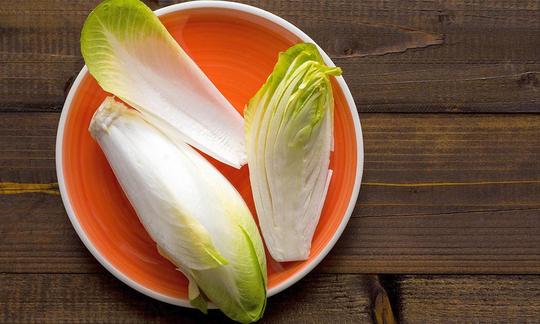

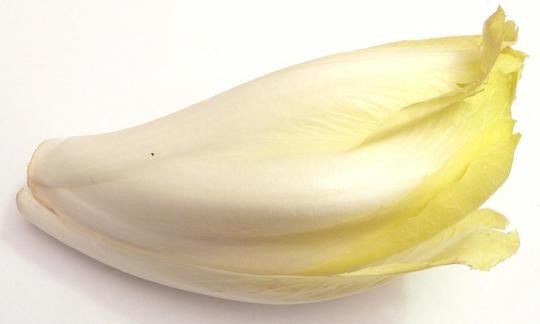

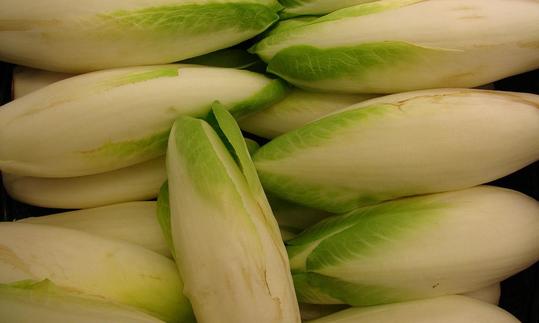

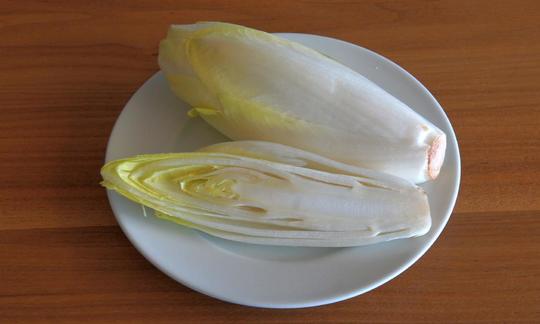


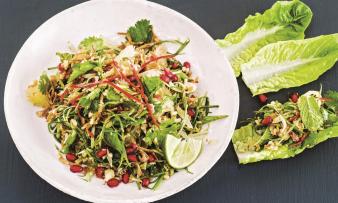
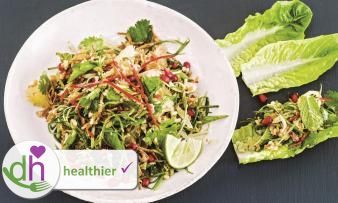





Comments